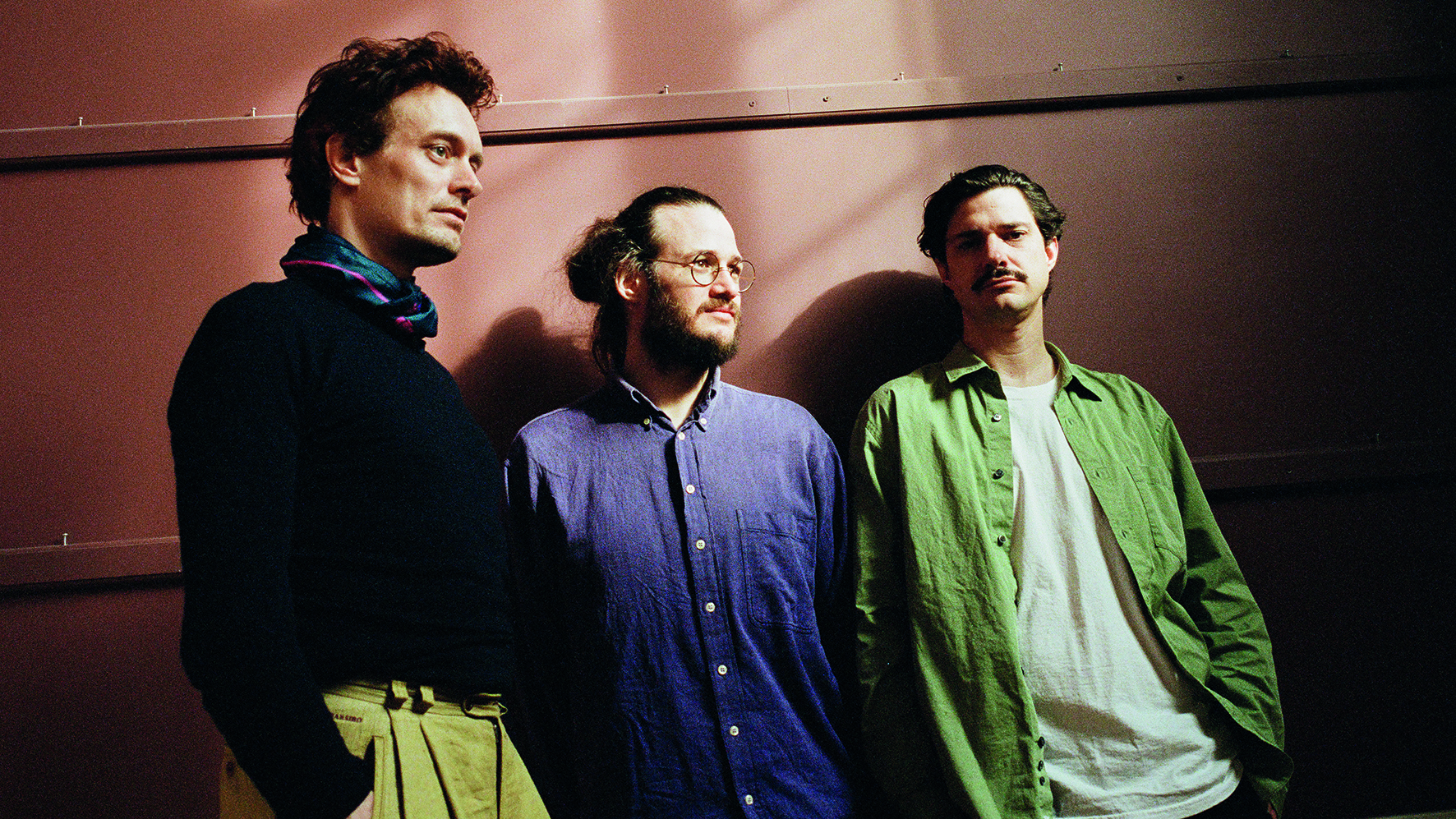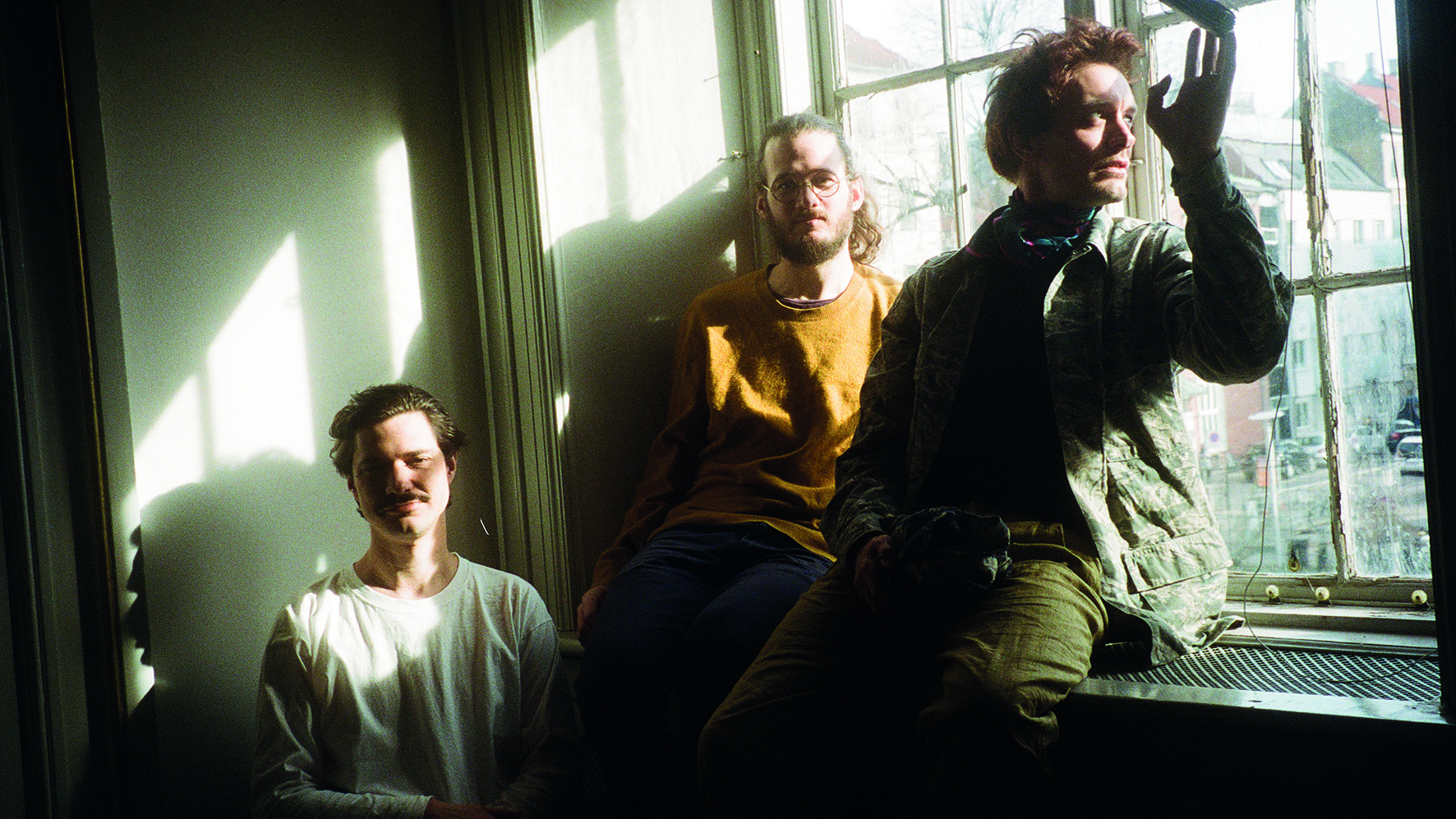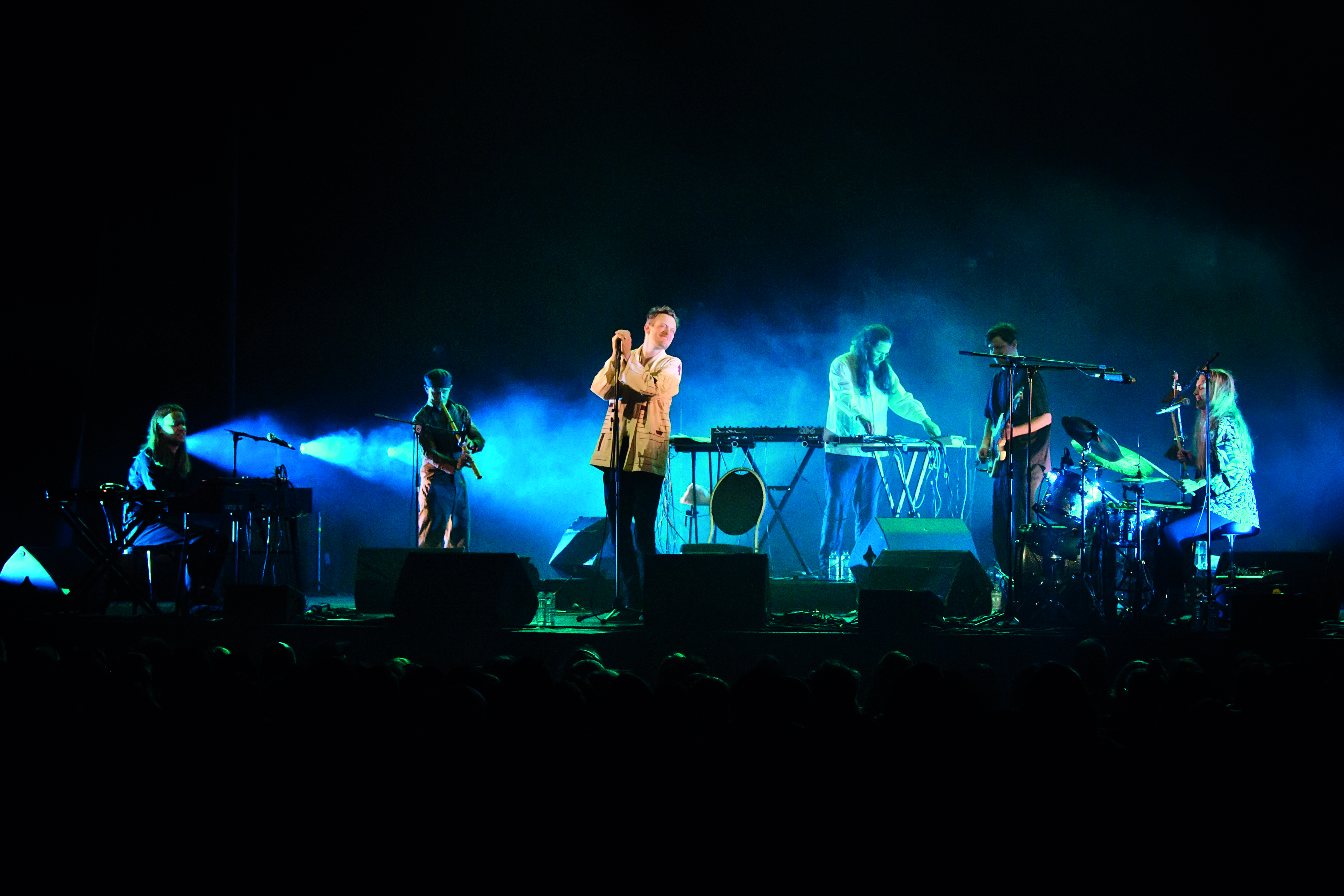Efterklang: "People say, ‘What’s the point of using analogue synths? You have to print them anyway, so they still end up in the computer’. That’s true, but it just feels better for me"
Producer Mads Brauer explains how the experimental Danish trio have gone back to basics for their latest album – and back to nature

Mads Brauer’s Copenhagen home isn’t far from the beach. Even in the middle of this busy, 21st century city with its 10 million tourists, he likes the idea that there is still a small connection with nature.
“Something as simple as the smell of the sea can make that connection for me,” explains ‘electronics’ chief Brauer. “The salty air… the strong breeze. Without it, I think the music of Efterklang would suffer.”
Along with Casper Clausen and Rasmus Stolberg, Brauer is part of the core trio that has existed at the heart of Efterklang for 20 years. The experimental soundscapers have been friends since school, growing up in a pre-internet rural Denmark that was dominated by the Top 40 and daytime radio.
“When you think back, it’s amazing how limited our access to music was,” remembers Brauer. “The only alternative music I got to hear was grunge when Nirvana became huge. At the time, I was playing the guitar, so I was at least able to have some fun. Turn up the amp and make some noise.
“We were just young kids who didn’t really know too much about all the other music that was out there in the world. It sounds kinda scary, really. All this music was happening, but we didn’t know about it. It was only after we all moved to Copenhagen when I was 18 that things started to change. Suddenly, we had more record shops and clubs to choose from, and the internet was beginning to give everyone access to music from around the world.
We started to think seriously about what else we could do with our music. How far could we travel with sound?
“It wasn’t long after we got to Copenhagen that I heard the Autechre album, Amber. That was the point at which music changed. By the time I got to the last track, I was bored with the guitar. As a band, we started to think seriously about what else we could do with our music. How far could we travel with sound?”
The band’s debut release, 2003’s Springer, would soon enough answer that question. A mix of otherworldly melodies, chiming guitars, drifting synth drones, glitched rhythms and melancholy vocals, it shared DNA with the likes of Sigur Rós and the aforementioned Autechre, but still managed to add something that was distinctly Efterklang.
Want all the hottest music and gear news, reviews, deals, features and more, direct to your inbox? Sign up here.
Tripper soon followed in 2004, but it was the 2007 album, Parades, where the band really found what they were looking for. How would you describe Parades? An acoustic/electronic cabaret? Or the soundtrack to an unreleased Lars Von Trier mind-bender? Maybe the best of Vernon Elliott scored for glitch plugins?
Such was Parades’ impact that, in 2008, the Danish National Chamber Orchestra enquired about a collaboration and ended up performing the album live with the band. (One of the performances is out there on YouTube, complete with a selection of ‘interesting’ hats.)
As you’d expect, the most recent album isn’t quite as collaborative. With the world in the grip of lockdown/Covid, the band disappeared to a deserted farmhouse on a tiny island south of Copenhagen. Ironically, Windflowers, released in October, has turned out to be what many are calling the band’s most ‘accessible’ album to date. As if, even in isolation, they longed for connection with others… something we all experienced over this last 18 months.

Is it fair of us to describe Windflowers a Covid album?
Mads Brauer: “Maybe that’s true. The way it came together was certainly a result of Covid. The normal ways of recording were closed off to us… we couldn’t just call up an orchestra and sit in the same room with 40 other people.
“So, we made a conscious decision to get away from the madness. We found a farm on an isolated island, moved some of our equipment there and started recording. There was already an old Mac Pro with a Pro Tools HD rig there, but we also brought our own Pro Tools system, based on an Apollo x8.
“There was actually a sense of relief when we finally started setting up all the gear. It was a relief to be out of the city. Immediately, I could feel positive energy starting to flow and the world making sense again. All of our focus could be directed at the music.”
You couldn’t do that in the city? Not even with the aforementioned salty sea air wafting through the studio?
MB: “Well, yes, that is possible, and we have done it in the past. Inspiration can be found anywhere. Sometimes, when I’m down at the beach looking over the water, I can see wind turbines, the big oil tankers, and the sun on the water. There is a certain kind of beauty in that scene, but it’s not a complete feeling. There are still too many distractions.
We were adding all sorts of strange sounds, building and building these massive Pro Tools sculptures
“We all grew up in the countryside. We are used to the open skies and the trees. And those feelings have always been present inside our music. The view from our window or the colour of the sky will make an appearance in how the music is constructed. Being in the countryside keeps me grounded and it allows me to stay inside my mind. If things are getting difficult in the studio, I can go for a walk and, 30 minutes later, all the problems have gone.
“Even the name of this album comes from nature. Each year, there is a certain flower that will suddenly arrive in the forest in April. It almost seems that one day, the flowers are not there, but the next day, they are covering the forest floor like a beautiful white carpet. And they disappear just as quickly. An explosion of colour, then they are gone. Every year, they mark the changing of the seasons… the passing of our lives. People call them windflowers.
“The album was recorded over five different periods at the farm and nature became part of the reason we wanted to be there. The flowers in spring, the glorious days of summer and even the freezing winter, when everything was covered in snow. We spend so much of our lives in virtual worlds, these days. Maybe we all need to get back to the real world. Get back to basics.”
So, without the complication of Covid, maybe this album wouldn’t have got made? You would have been in the studio with a 300-piece orchestra?
KM: [laughs] “Who knows? There were a few collaborations on Windflowers, but it felt like a real DIY album, similar to how we used to work 20 years ago. No big plan. Just switch on the equipment and go wherever the music wants to go.”
When you’re 18, you think that all the grown-ups who work in music shops know what they are talking about
With that in mind, did the 2008 collaboration with the Danish National Chamber Orchestra feel like a challenge for you? Not really DIY, is it?
MB: “I think it’s something that a lot of bands must dream about. You’re in the studio and you add some strings to one of your songs, then you suddenly start imagining an entire orchestra. What would our music sound like if we had this and this and this? The way that Parades was recorded naturally led us down that road. It was the product of lots of different recording sessions with strings and choirs.
"We were adding all sorts of strange sounds, building and building these massive Pro Tools sculptures. Trying to find room for all of the different bits to the songs. Electronics, acoustic instruments, voices, machines… all of them weaving in and out. Trying to find a meeting point for all of those elements.
“Before we actually sat down with the orchestra, we had a very fortunate meeting with Karsten Fundal. He’s a composer who’s worked with Den Sorte Skole and many other Danish acts, and he has done film scores for Ai Weiwei and Joshua Oppenheimer. He was the first one that helped us look at the Parades album and translate it into something bigger, something we could play live. Over the next few weeks, Efterklang grew from five people to 13 people.
“But even when things had started to grow, the idea of playing with a full orchestra still felt like a silly joke. It was only when the Danish National Chamber Orchestra actually contacted us that we began to take it seriously.
"There was a big thing in Denmark at the time: orchestras were looking to collaborate with non-classical musicians. Bringing two different audiences together. What could we say? Of course! It was hard to make the whole thing work, but it was also a rare chance for us to hear our music in a totally different setting.”
How did the change take place? Did you give your music to the orchestra and let them come up with their own ideas?
MB: “Right from the beginning, it was clear that the way we had recorded the album was too fragmented. Yes, the melodies were present, but there were all sorts of gaps that didn’t feel right for an orchestra. The first job was to make the original music feel more cohesive; after that process, we really started to think about how the orchestra could be used to help add support or colour.
“Karsten [Fundal] was very important at this stage. He had the ability to keep hold of the initial spirit of the album, but still add something from the orchestra. He didn’t just say, ‘OK, this is the album, here is the sheet music. We’re going to perform Parades with some big strings and that’s the whole story’. He completely understood that we wanted to create something new.”
You mentioned Pro Tools earlier. Is that still your main platform?
MB: “The first DAW I ever used was Cubase when I was at school. It was still very limited back then. I seem to remember difficulties with the amount of audio you could record and the latency was out of this world. Then I bought Pro Tools LE. Why Pro Tools? I honestly don’t know. I think it was a simple case of going into a music shop and some guy telling me that Pro Tools was pretty good. When you’re 18, you think that all the grown-ups who work in music shops know what they are talking about.
Sometimes, the technology would feel too powerful and we were out in the cold. Sitting in the corner, looking at the computer, thinking, ‘Hey, what about us?'
“As it turned out, Pro Tools has been perfect and, yes, it’s still the one we use most. We have got others loaded on to the computer – Logic and Ableton – but no one has been able to give me a good reason why I should change to a different platform, so I can’t see that happening any time soon. OK, there were a few logistical problems with Pro Tools in the early days, but we’re now at a stage where technology is no longer seen as a hurdle. It’s all designed to make it easier for us to make music.”
Even though you’re often seen as an ‘electronic’ band, there always seems to be a strong human presence in your music. It’s hard to listen to Efterklang without a vision of people standing around in a room, playing instruments. Was that something that just happened naturally or did you plan for that all along?
MB: “Right at the start, we were a normal band. We were people playing instruments. Then, we discovered all these great machines that could help us make music and we started looking at ways we could integrate the machinery into our band. It was always meant to be a collaboration… we didn’t want the machines to take over.
“But finding the exact point where we could join those two ideas was quite difficult. In the early days, we just ended up sounding like Radiohead. All our music could have been taken from OK Computer. For the next two or three years, we started investigating different ideas and different bits of equipment. Sometimes, the technology would feel too powerful and we were out in the cold. Sitting in the corner, looking at the computer, thinking, ‘Hey, what about us? Can you give us something to do.’
“The key that finally opened the door was the MPC2000. It was an instrument that allowed us to make machine music. We could use it to sample and create sounds… we could build songs. In a strange way, it allowed us creep into the electronic world and find a place that was comfortable for us. Maybe it was the fact that the MPC doesn’t use a mouse. Even today, clicking a mouse feels like an odd way to write music. I have to use a mouse, but the less time I spend with it, the happier I am.
“I think you can see that quite well in my choice of synths.”

All analogue?
MB: “Mainly. The Sequential OB-6, Elektron Analog Keys and a modular synth based around a Furthrrrr generator oscillator. They’re all constantly hooked up to the computer, so they are available for me immediately. Some people say, ‘What’s the point of using analogue synths? You have to print them anyway, so they still end up in the computer’. That’s true, but it just feels better for me. I like the fact that I am being given a limit and I have to make a decision.
“There is a track on the new album called House On A Feather. It’s based on a simple sketch that I made on the OB-6. As you know, it’s an analogue synth and sometimes the tuning is not so perfect. Basically, you need to calibrate it… tune the oscillators.

"But in this case, I actually chose to keep it in this detuned state as it has a special atmosphere. It turned out to be quite a challenge to record the song because we had to tune everything else using Melodyne and by ear. The results were very surprising. I was fascinated by how the voice can so easily adapt to different tunings, whereas the piano and bass guitar weren’t so happy in this new setting. I really like the slightly different colours of this track. It’s like looking through a stained-glass window.”
“I do use Max/MSP, which you could call a software synth. But MSP is different because it doesn’t offer instant gratification. You try this bit here and maybe it works, maybe it doesn’t. OK, so let’s try something over here. It’s the complete opposite of the instant preset mentality.
"You have no idea what you’re going to end up with and you can easily spend a whole morning creating something that has no use whatsoever. You need to have patience and you need a particular kind of mindset; a bit like building something out of Lego.
That is the big dilemma for musicians today. How deep do you dive into software? How big do you want to make your music?
“I will admit that I have used a couple of actual software synths. There’s one called LION by Unfiltered Audio. As soon as I heard it, I liked the way it sounded and the minimal interface, but it wouldn’t let me save anything, so I ended up having to use it like a hardware synth. Maybe it was a message from the synth gods… do not rely on software.
“I guess that is the big dilemma for musicians today. How deep do you dive into software? How big do you want to make your music? Ideally, I would only ever have 24 tracks of audio. You try to set limits, but, in reality, that never happens. You try to leave a few accidents and errors in the music, but it is so easy to fix any problems.
“As a musician in 2021, you have to be very careful because you can just keep going… you can build your song higher and higher. You can make it all clean and tidy, with nothing out of place. Everything is perfect. Plus, you can build it so much quicker than you used to build it 20 years ago.
“But that’s when you have to ask yourself whether that will be the best song for you? Do you want to be surrounded by clean, faultless music? To me, that sounds a bit… boring.”
Efterklang’s new album, Windflowers, is out now.


Computer Music magazine is the world’s best selling publication dedicated solely to making great music with your Mac or PC computer. Each issue it brings its lucky readers the best in cutting-edge tutorials, need-to-know, expert software reviews and even all the tools you actually need to make great music today, courtesy of our legendary CM Plugin Suite.
